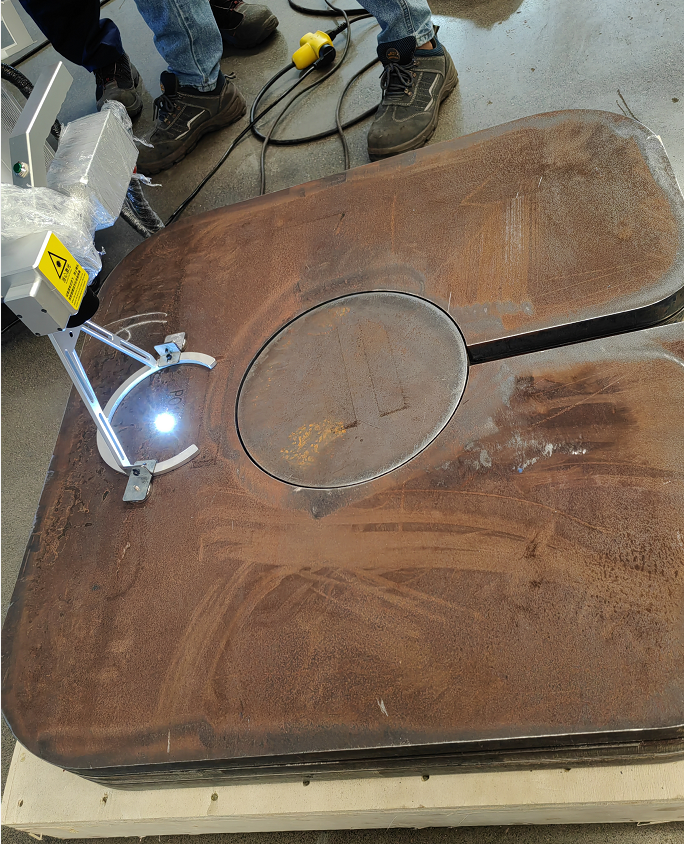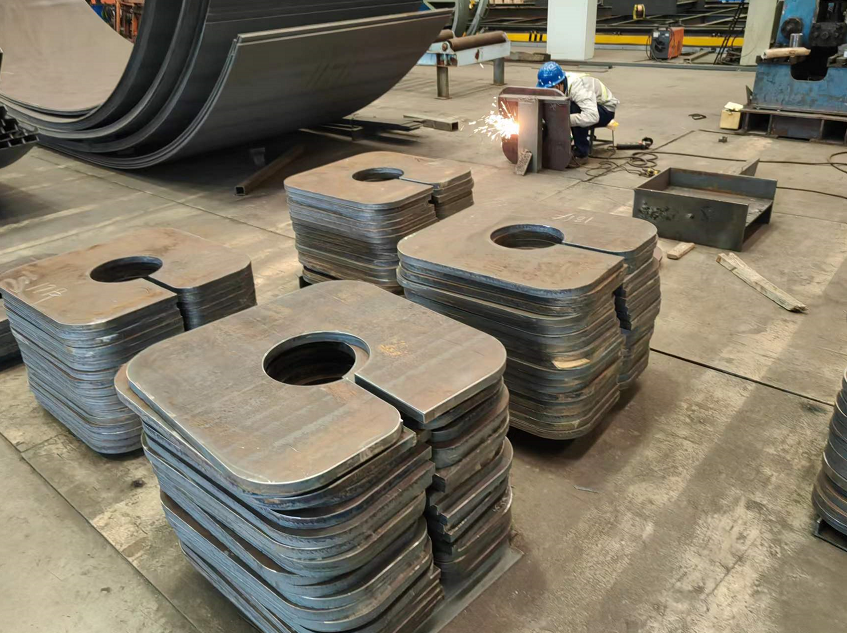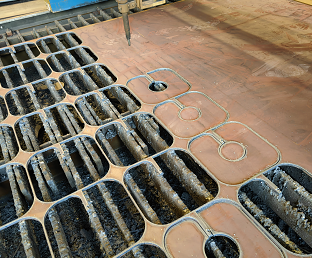Wear resistant steel cutting parts
1. High wear resistance
(1) The carbon content in the alloy layer of bimetal wear-resistant plate is 4.5-5.5%, the chromium content is more than 30%, the volume fraction of Cr7C3 carbide in the wear-resistant layer is 50-70%, the macro hardness is hrc60-64, and the micro hardness of chromium carbide is hv1400-1800. The distribution direction of carbide is perpendicular to the wear direction, which greatly enhances the service life of the wear-resistant layer.
(2) In addition, ceramic wear-resistant particles can be added according to actual working conditions and customer requirements, with small particle size, which can enhance the overall hardness of the matrix and improve the wear resistance of the material.
(3) The wear resistance of self-developed and designed bimetal wear-resistant plate is 15-20 times that of ordinary carbon steel; 7-8 times of high manganese steel; 6 times of stainless steel; 8 times of alloy cast steel.
2. It has good high strength and impact resistance
The base plate of the composite wear-resistant plate is made of ductile materials such as low carbon steel, low alloy steel or stainless steel, which shows the advantages of bimetal. The wear-resistant layer resists the wear of the wear medium, and the substrate bears the load of the medium, so it has good impact resistance.
3. Good reprocessability
Composite wear-resistant plate can be cut, leveled, punched, bent and crimped. It can be made into flat plate, arc plate, cone plate and cylinder. The cut composite wear-resistant plate can be welded into various engineering structures or parts. The composite wear-resistant plate can also be heated and pressed into a complex shape with a mold. The composite wear-resistant plate can be fixed on the equipment by bolts or welding, which is convenient for replacement and maintenance.
4. High cost performance
Although the manufacturing cost of composite wear-resistant plate is higher than that of ordinary steel or wear-resistant materials, its service life is increased several times, which greatly reduces the maintenance cost and shutdown loss. Its price performance is about 2-4 times higher than that of ordinary materials. The greater the material handling capacity, the more serious the equipment wear, the more obvious the economic effect of using wear-resistant composite steel plate.
Composite wear-resistant plate has the characteristics of high wear resistance, impact resistance and easy processing. It can be connected with other structural parts by welding, plug welding and bolt connection. It is widely used in ports, docks, metallurgy, cement, coal, power, mines, steel, building materials, bricks and other industries. Compared with other wear-resistant materials, it has higher cost performance and has been favored by more and more manufacturers and customers.
Bimetal composite wear-resistant steel plate is composed of low-carbon steel plate and alloy wear-resistant layer, and the wear-resistant layer generally accounts for 1 / 3-1 / 2 of the total thickness. During operation, the matrix provides comprehensive properties such as strength, toughness and plasticity to resist external forces, and the wear-resistant layer provides wear-resistant properties to meet the requirements of specified working conditions.
The alloy wear-resistant layer of wear-resistant steel plate is metallurgical bonding with the matrix. Through special equipment and automatic welding process, the high hardness self protective alloy welding wire is evenly welded on the base material. The number of composite layers is from one layer to two layers or even multiple layers. During the composite process, uniform transverse cracks appear due to different alloy shrinkage ratios, which is a remarkable feature of wear-resistant steel plates.

The wear-resistant layer is mainly composed of chromium alloy, and other alloy components such as manganese, molybdenum, niobium and nickel are also added. The carbides in the metallographic structure are distributed in the form of fibers, and the fiber direction is perpendicular to the surface. The micro hardness of carbides can reach hv1700-2000 and the surface hardness can reach HRC58-62. The alloy carbide has strong stability at high temperature, maintains high hardness, and has good oxidation resistance. It can be used normally under 500 ℃.
The wear-resistant steel plate has high wear resistance and good impact performance. It can be cut, bent and welded. It can be connected with other structures by welding, plug welding and bolt connection. It is time-saving and convenient in the process of maintenance. It is widely used in metallurgy, coal, cement, power, glass, mining, building materials, bricks and other industries. Compared with other materials, it has high cost performance, It has been favored by more and more industries and manufacturers.
application
1) Thermal power plant: medium speed coal mill barrel lining plate, fan impeller shell, dust collector inlet flue, ash duct, bucket turbine lining plate, separator connecting pipe, coal crusher lining plate, coal hopper and crusher lining plate, burner burner, coal hopper and funnel lining plate, air preheater support bush, separator guide vane. The above parts have no high requirements on the hardness and wear resistance of the wear-resistant steel plate, and the wear-resistant steel plate made of NM360 / 400 with a thickness of 6-10mm can be used.
2) Coal Yard: feed chute and hopper lining, hopper lining, fan blade, pusher bottom plate, cyclone dust collector, coke guide lining plate, ball mill lining, drill bit stabilizer, spiral feeder bell and base, Kneader bucket lining, annular feeder and dumper bottom plate. The working environment of the coal yard is harsh, and there are certain requirements on the corrosion resistance and wear resistance of the wear-resistant steel plate. It is recommended to use the nm400 / 450 Hardox400 wear-resistant steel plate with a thickness of 8-26mm.
3) Cement plant: chute lining, end lining, cyclone dust collector, separator blade and guide blade, fan blade and lining, reclaimer bucket lining, screw conveyor bottom plate, pipe assembly, frit cooling plate lining, conveyor slot lining. These parts also need wear-resistant steel plates with better wear resistance and corrosion resistance, and wear-resistant steel plates with NM360 / 400 Hardox400 thickness of 8-30mmd can be used.
4) Loading machinery: unloading mill chain plate, hopper lining plate, grab blade plate, automatic dump truck dump plate, dump truck body. This requires wear-resistant steel plates with extremely high wear resistance and hardness. It is recommended to use wear-resistant steel plates made of nm500 hardox450 / 500 with a thickness of 25-45mm.
5) Mining machinery: lining plate and blade of ore and stone crusher, lining plate and baffle of conveyor. This kind of parts need extremely high wear resistance. The available material is nm450 / 500 hardox450 / 500 wear-resistant steel plate with a thickness of 10-30mm.
6) Construction machinery: Cement pusher tooth plate, concrete mixing building, mixer lining plate, dust collector lining plate, brick machine mold plate. It is recommended to use NM360 / 400 wear-resistant steel plate with thickness of 10-30mm.
7) Construction machinery: loader, bulldozer, excavator bucket plate, side blade plate, bucket bottom plate, blade, rotary drilling rig drill pipe. This kind of machinery needs wear-resistant steel plates with particularly strong and extremely high wear resistance. The available material is nm500 hardox500 / 550 / 600 high-strength wear-resistant steel plates with a thickness of 20-60mm.
8) Metallurgical Machinery: iron ore sintering machine, conveying elbow, iron ore sintering machine lining plate, scraper machine lining plate. This kind of machinery needs wear-resistant steel plate with high temperature resistance and high hardness. Therefore, hardox600 hardoxhituf series wear-resistant steel plate is recommended.
9) The wear-resistant steel plate can also be applied to the cylinder and blade of sand mill, various parts of freight yard and wharf machinery, bearing structure, railway wheel structure, roller, etc.

Related News
Submitted successfully
We will contact you as soon as possible


















